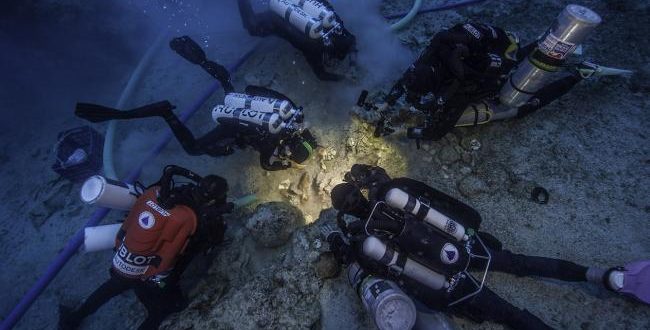2000-year-old human skeleton found in Antikythera Shipwreck could yield first DNA from an ancient shipwreck victim.
The bones were discovered on August 31 off the coast of the Greek island Antikythera, and the AFP news agency said that they were surprisingly well-preserved given their age. Currently, the individual’s identity is unknown, but that may change if DNA can be recovered from the bones.
The skeleton was discovered by researchers at the Hellenic Ministry of Culture and Sports and Woods Hole Oceanographic Institution (WHOI) in Massachusetts. Thus far, they have recovered a partial skull (which includes the jaw and teeth), two long arm bones, both femurs, and multiple ribs, with additional bones embedded in the seafloor and awaiting excavation.
WHOI underwater archaeologist and excavation co-director Brendan Foley told Nature that he and his colleagues were “thrilled” by the find, which is rare because in most cases, the victims of shipwrecks are swept away by currents and eaten by fish within a period of decades. These bones have survived centuries, he said. “We don’t know of anything else like it.”
Scientists hope to recover DNA from the newfound bones
Foley’s team recovered the remains from the Antikythera Shipwreck, a well-known wreck that contains the remains of a Greek trading ship dating back to around 65 BC and which was found off the island of Antikythera in the Aegean Sea (hence the name given to the shipwreck).
While this is the first skeleton to be recovered from the wreck, it gained notoriety following the discovery of a technological device known as the Antikythera Mechanism, a complicated system composed of roughly 40 bronze cogs and gears used by the ancient Greeks to monitor the cycles of the solar system, the AFP said. It preceded similar European devices by some 1,500 years.
The scientists claim that the skeleton is the first to be recovered from an ancient shipwreck in the era of DNA analysis, and in a statement, DNA expert Dr. Hannes Schroeder from the Natural History Museum of Denmark in Copenhagen (who will be studying the remains once he receives permission to do so from the Greek government) said that the bones are so well preserved that he may be able to identify the individual’s ethnicity and geographic origin.
“Against all odds, the bones survived over 2,000 years at the bottom of the sea and they appear to be in fairly good condition, which is incredible,” Dr. Schroeder said. He told Nature that the fact that the archaeologists were able to recover the petrous bones (bones located behind the ear) was fortuitous, as they tend to preserve genetic material better than other parts of the skeleton. “If there’s any DNA,” he explained, “then from what we know, it’ll be there.”
“This is the most exciting scientific discovery we’ve made here,” Foley told The Guardian. His colleague Dr. Schroder added that it remained to be seen how successful the team’s attempts to recover DNA from the newfound skeleton would be. “This is uncharted waters,” he explained. “I’ve never dealt with submerged remains like this before. We won’t know if it works until we try, but it is definitely worth trying.”
Agencies/Canadajournal
 Canada Journal – News of the World Articles and videos to bring you the biggest Canadian news stories from across the country every day
Canada Journal – News of the World Articles and videos to bring you the biggest Canadian news stories from across the country every day



